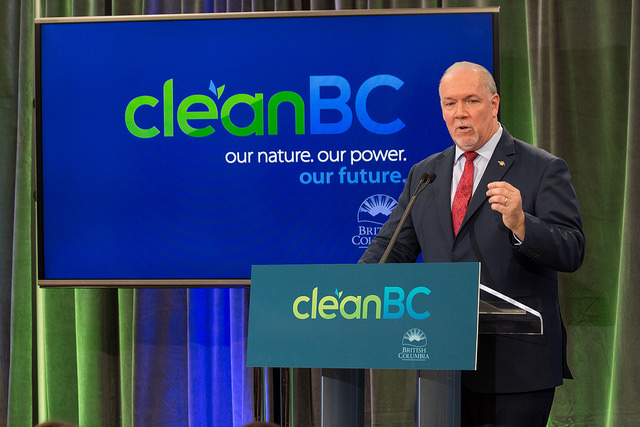
Articles suggérés
Sur des sujets similaires
Notre équipe spécialisée en affaires publiques à Vancouver décortique le plan de croissance propre récemment dévoilé par le gouvernement provincial de la Colombie-Britannique. (L'article est en anglais.)
———
On December 5, B.C.’s Premier John Horgan announced CleanBC, the provincial government’s new plan to reduce carbon emissions and build a low-carbon economy. Billed as both a climate plan and an economic development strategy, CleanBC builds on B.C.’s abundant clean energy resources to transition away from fossil fuels and includes ambitious goals to reduce emissions in the province’s buildings, transportation, and industrial sectors.
Reasserting B.C. as a national leader on climate action, Premier Horgan announced the plan as other provinces continue to feud with Ottawa over the national carbon price that is set to to take effect on January 1, 2019.
The CleanBC plan will account for approximately 75% of the province’s legislated climate target to reduce the province’s GHG emissions by 40% below 2007 levels by 2030. The remaining 25% of the reductions will be identified over the next 18-24 months and will primarily focus on industrial electrification, public transit, heavy-duty trucks and freight, and clean technology.
In his remarks, Horgan paid tribute to former Premier Gordon Campbell, “who had the courage to implement the first carbon tax.” B.C.'s carbon tax increased from $30 to $35 per tonne of carbon emissions this past April and the tax will increase by $5 per tonne each year until it reaches $50 in 2021.
To transition away from fossil fuels and electrify B.C.'s economy the CleanBC plan requires an additional 4,000 gigawatt-hours of electricity or roughly 8% of BC Hydro’s current system-wide capacity.
 B.C. Premier John Hogan (Image credit: Province of British Columbia / Flickr)
B.C. Premier John Hogan (Image credit: Province of British Columbia / Flickr)
See NATIONAL's detailed breakdown of the CleanBC growth plan below or read the full plan here.
CleanBC highlights
Buildings
Buildings presently account for 12% of B.C.’s GHG emissions. Key policy actions include:
- Making every building more efficient by changing the B.C. Building Code and increasing efficiency standards – until every new building is “net-zero energy ready” by the year 2032
- Making heat pumps more affordable and homes more energy-efficient through incentives
- Upgrading B.C.’s public housing units to make them more energy-efficient
- Making residential natural gas consumption cleaner by putting in place a minimum requirement of 15% to come from renewable gas
- Helping remote communities reduce their dependence on diesel
- Supporting public infrastructure efficiency upgrades and fuel switching to biofuels with the CleanBC communities fund
- The policy actions in B.C.’s built environment are expected to cut carbon emissions by 2.0 Mt by 2030.
Transportation
B.C.'s transportation sector accounts for about 37% percent of B.C.’s GHG emissions. Key policy actions include:
- Mandating that every new car sold in B.C. will be a zero-emission vehicle (ZEV) within 20 years
- Providing ZEV incentives to help people afford cleaner cars and save money on gasoline bills
- Making it easier to charge or fuel a ZEV or hydrogen car with new charging infrastructure
- Increasing B.C.’s low carbon fuel standard to 20% by 2030 and increasing the production of renewable transportation fuels
- Increasing tailpipe emissions standards for vehicles sold after 2025
- Together, the CleanBC transportation policy actions are expected to reduce GHG emission by 6.0 Mt by 2030.
Industry
As part of CleanBC, the Province and the Business Council of British Columbia signed an MOU to develop a low-carbon industrial strategy. The strategy will focus on maintaining the competitiveness of B.C. companies, acknowledging that energy-intensive, trade-exposed industries (EITIs) face competitive pressure from industries in jurisdictions without carbon pricing. Key policy actions include:
- Directing a portion of B.C.’s carbon tax into incentives for cleaner operations
- Partnering with the Vancouver Fraser Port Authority on a Clean Trucking pilot project to switch 1,700 freight trucks to natural gas and low or zero-carbon fuel by 2030
- Reducing methane emissions from upstream oil and gas operations by 45%
- Providing clean electricity to planned natural gas production in the Peace region
- Increasing access to clean electricity for large operations with new transmission lines and interconnectivity to existing lines
- Ensuring a regulatory framework for safe and effective underground CO₂ storage and direct air capture
- Making industrial natural gas consumption cleaner by putting in place a minimum requirement of 15% to come from renewable gas
- Policy actions in B.C.’s industrial sector are expected to reduce B.C.’s carbon emissions by 8.4 Mt by 2030, the largest sectoral reduction in the CleanBC plan.
Adapting to climate change
Climate impacts are being felt in B.C. and the world over. The Province is developing an adaption strategy that will guide the Province’s response to our changing climate. B.C.’s Climate Action Secretariat will first conduct a climate risk assessment to identify and measure provincially significant climate-related risks. This assessment will inform the Province’s adaptation strategy in 2020.
——— Michael Goehring était partenaire au Cabinet de relations publiques NATIONAL
——— Elizabeth Wells était chargée de projets au Cabinet de relations publiques NATIONAL
